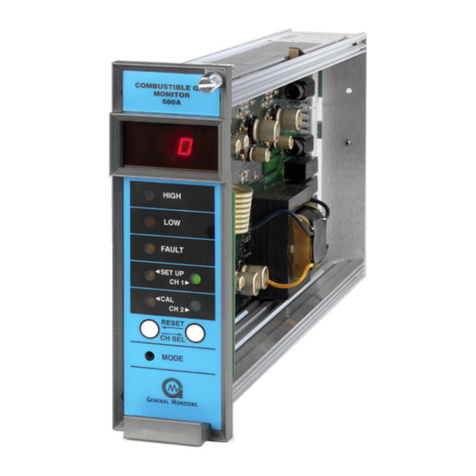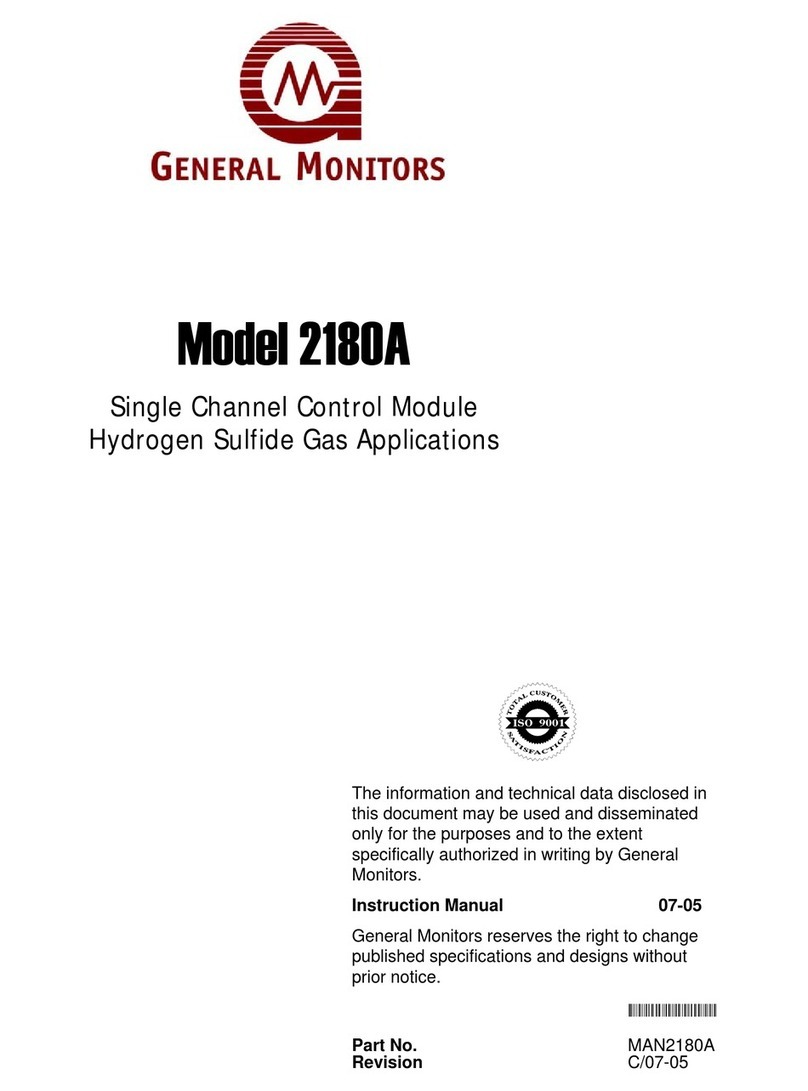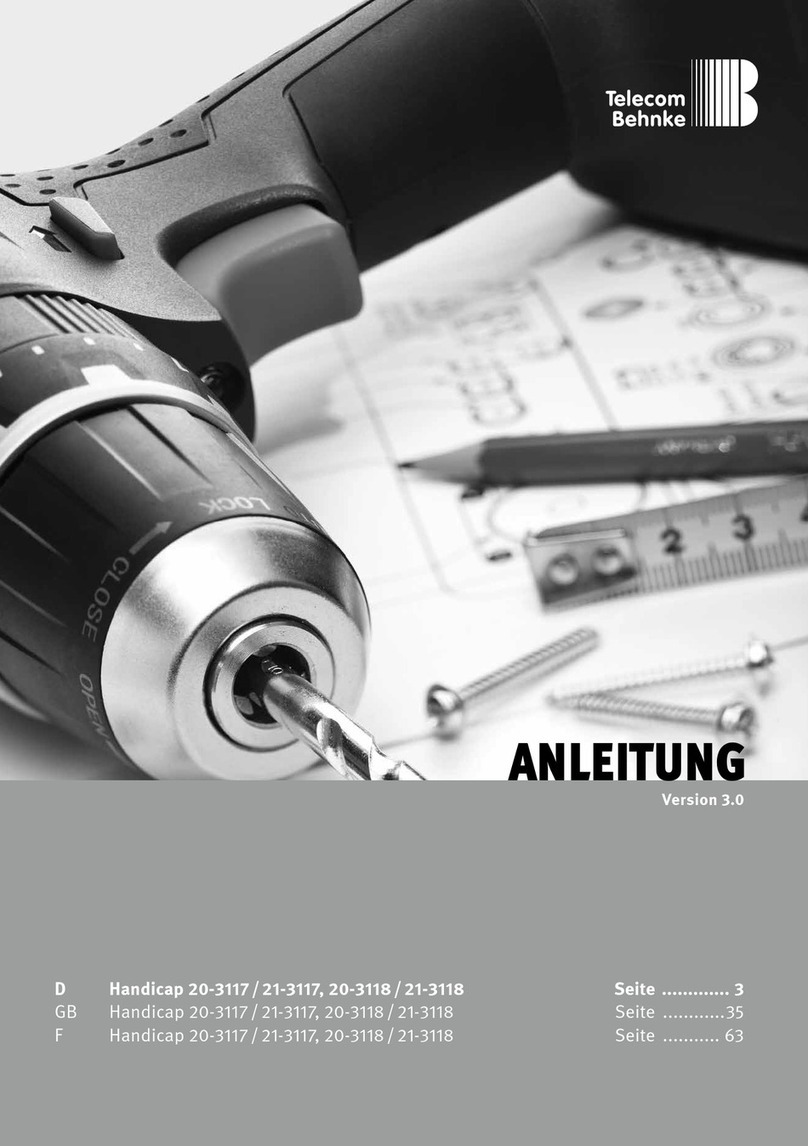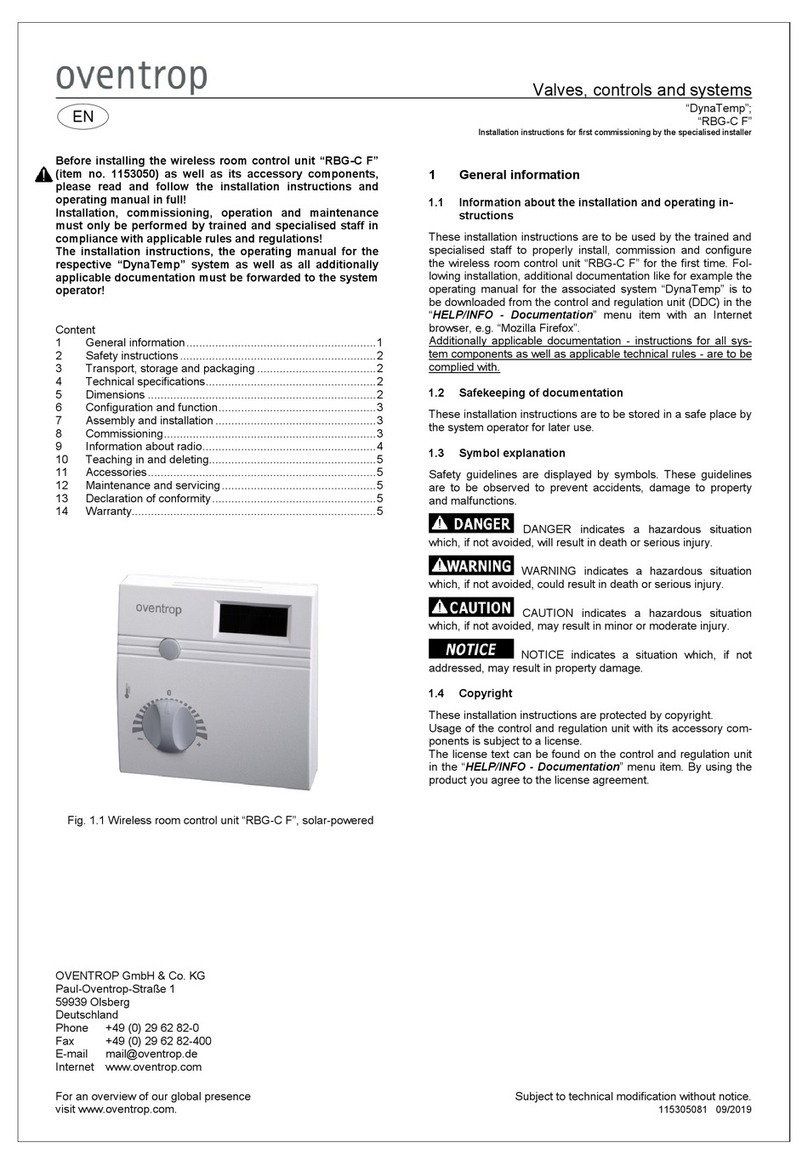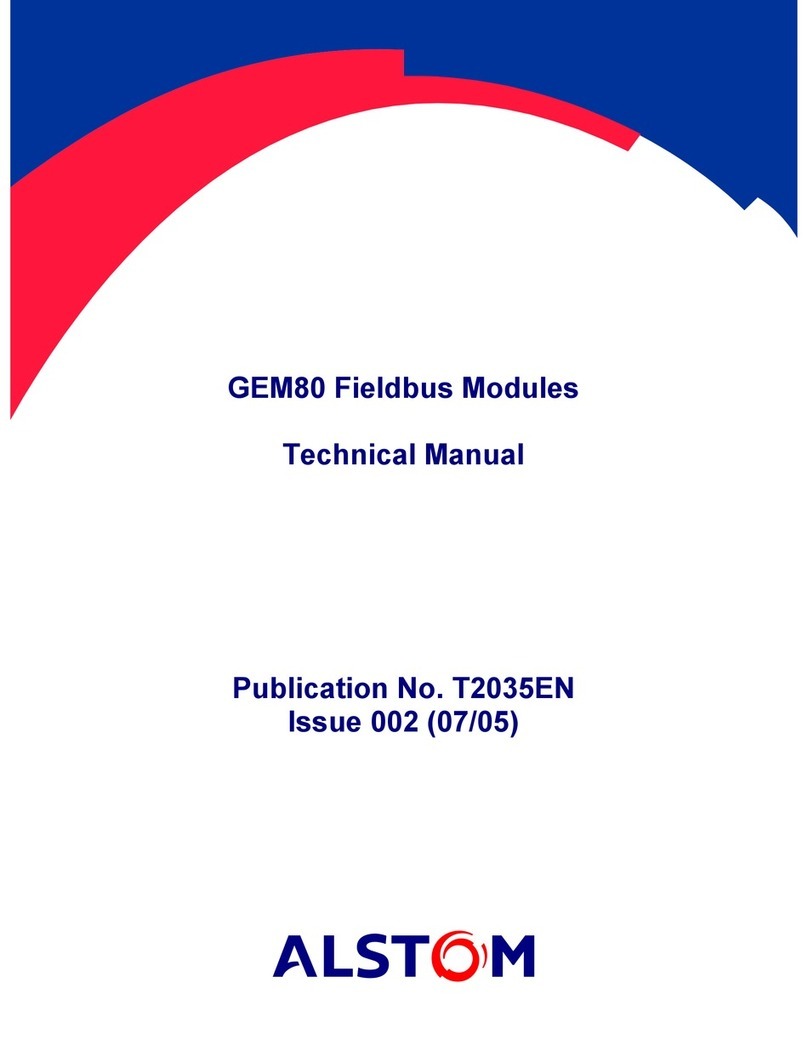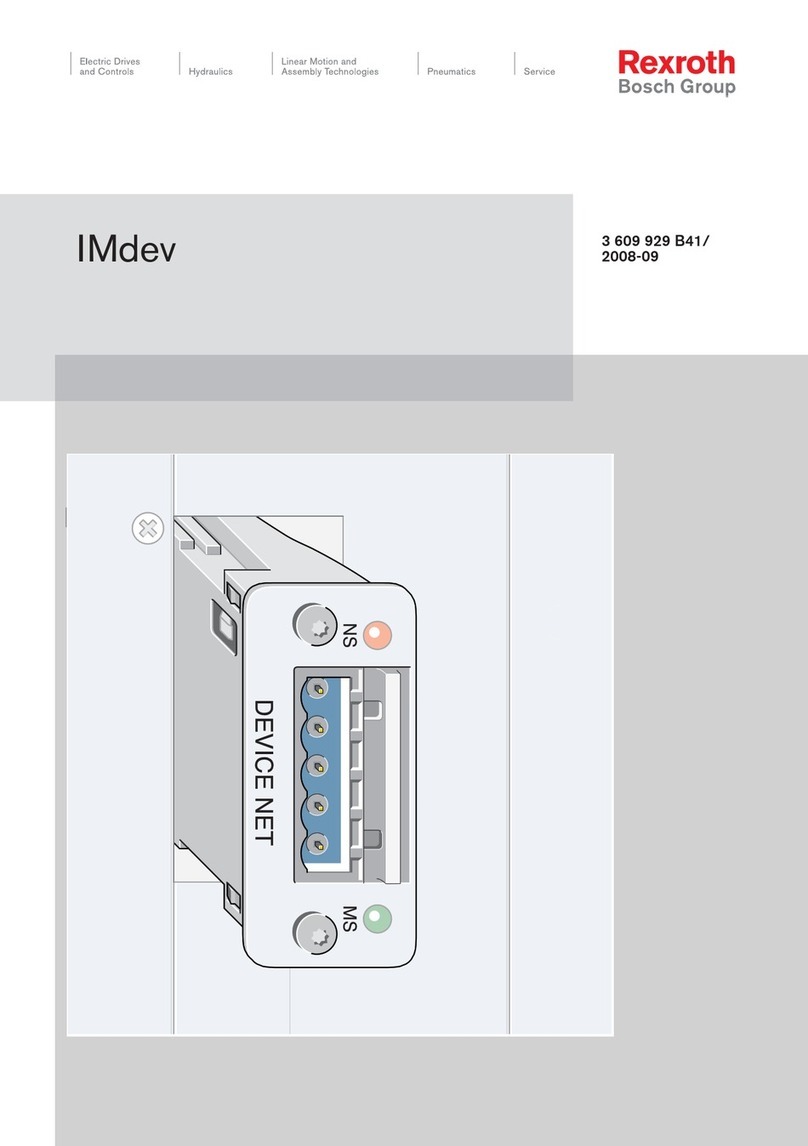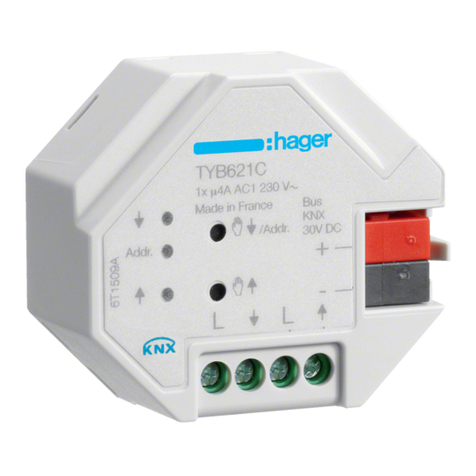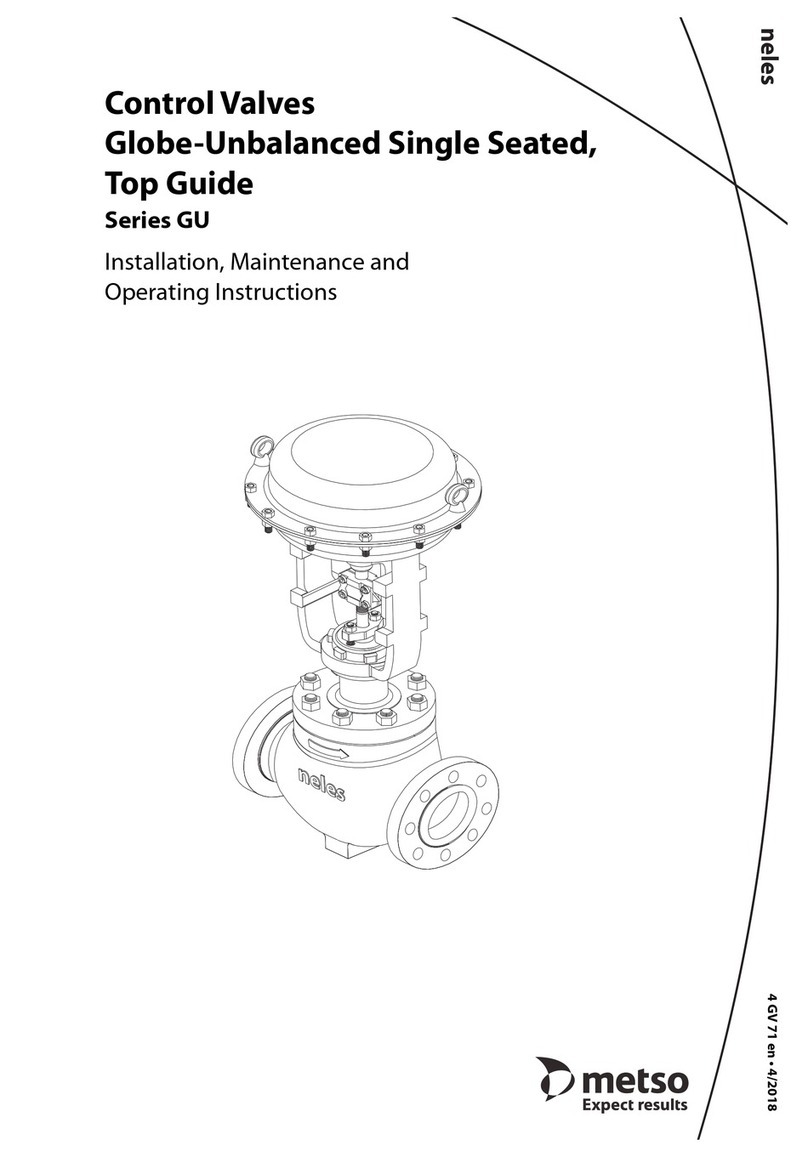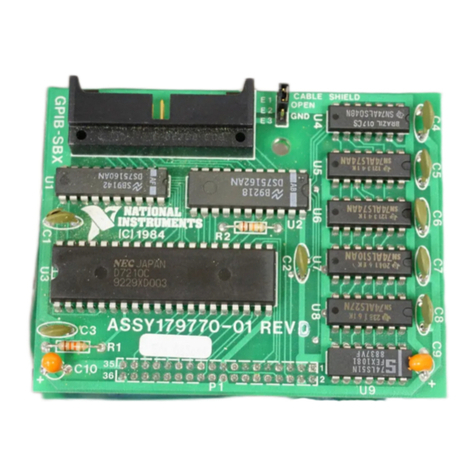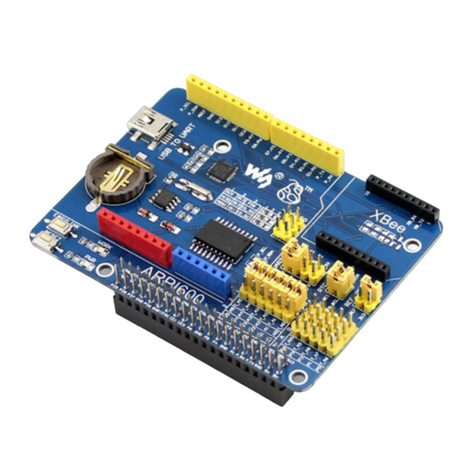General Monitors 4802A User manual

Model 4802A
Zero Two Series Control Module
For Combustible Gas A
pp
lications
The information and technical data disclosed in
this document may be used and disseminated
only for the purposes and to the extent
specifically authorized in writing by General
Monitors.
Instruction Manual 08/05
General Monitors reserves the right to change
published specifications and designs without
prior notice.
Part No. MAN4802A-EU
Revision M/08.05

Model 4802A
i
Warranty Statement
General Monitors warrants the Model 4802A to be free from defects in workmanship or
material under normal use and service within two (2) years from the date of shipment.
General Monitors will repair or replace without charge any such equipment found to be
defective during the warranty period. Full determination of the nature of, and
responsibility for, defective or damaged equipment will be made by General Monitors’
personnel. Defective or damaged equipment must be shipped prepaid to General
Monitors’ plant or the representative from which shipment was made. In all cases, this
warranty is limited to the cost of the equipment supplied by General Monitors. The
customer will assume all liability for the misuse of this equipment by its employees or
other personnel. All warranties are contingent upon proper use in the application for
which the product was intended and do not cover products which have been modified
or repaired without General Monitors’ approval or which have been subjected to
neglect, accident, improper installation or application, or on which the original
identification marks have been removed or altered. Except for the express warranty
stated above, General Monitors disclaims all warranties with regard to the products
sold, including all implied warranties of merchantability and fitness and the express
warranties stated herein are in lieu of all obligations or liabilities on the part of General
Monitors for damages including, but not limited to, consequential damages arising out
of/or in connection with the use or performance of the product.
Warnings
WARNING -COMBUSTIBLE & FLAMMABLE GASES AND VAPORS ARE VERY
DANGEROUS. EXTREME CAUTION SHOULD BE USED WHEN COMBUSTIBLE &
FLAMMABLE GASES AND VAPORS ARE PRESENT.
All Zero Two Series Modules contain components, which can be damaged by static
electricity. Special care must be taken when wiring the system to ensure that only the
connection points are touched.
Only Catalytic Bead sensors designed by General Monitors will work with the Model
4802A. Any attempt to use a sensor that has not been designed by General Monitors
will void the warranty.
WARNING -Installation and Maintenance must be carried out by suitably skilled and
competent personnel only.
Full backward compatibility can be specified at the time of order. If this configuration is
specified, the rear terminal output designations will be identical to the previous
generation of Zero Two Series Modules.
This generation of product can be distinguished from the previous generation by the
lack of a door on the front panel. Adjustments are not necessary on the current
generation of this product.

Model 4802A
ii
E C Declaration of Conformity in accordance with EC & ATEX Directives
We at General Monitors Ireland Ltd., Ballybrit Business Park, Galway, Republic of Ireland, hereby declare that
the equipment described below, both in its basic design and construction, and in the version or versions
marketed by us, conforms to the relevant safety and health related requirements of the appropriate EC
Directives, only as follows:
a) Conforms with the protection requirements of Council Directive 89/336/EEC, = Amd 92/31/68/EEC
relating to Electromagnetic Compatibility, by the application of:
A Technical Construction File No. GM 97005 and Competent Body Certificate No. 4473-95-106 and
Report No. 4473/1K8.
And
b) Conforms with the protection requirements of IEC 1010-1: 1990 + Amd 1:1992 +Amd 2: 1995 relating to
safety by the application of:
A Technical Construction File No. GM 97005 and Competent Body Certificate No. 4146/699L-6870,
4146/1119/9510 and 4146/1119/9507 issued by:
ERA Technology Ltd. Cleeve Road, Leatherhead Surrey KT22 7SA, England. Tel: +44 1372 367000
c) Conforms to EN50270:1999 as tested by ITS Testing & Certification Cleeve Road, Leatherhead Surrey
KT22 7SB. Report No. EM02006611.
This declaration shall cease to be valid if modifications are made to the equipment without our approval.
PRODUCT: Control Module for Combustible Gas Applications
MODEL: 4802A
It is ensured through internal measures and our ISO9001: 1994 certifications, that series production units
conform at all times to the requirements of these current EC Directives and relevant standards.
Note: The Following Information applies to ATEX.
This equipment has been assured for use as a safety related device under the terms of Directive 94/9/EC
EHSR 1.5.
General Monitors Ireland Ltd. in order to comply with ATEX will provide this Instruction Manual in a European
Language required to operate the product upon request. Should this be necessary, General Monitors Ireland
Ltd. should be notified of this request to allow adequate time to process the request.
ATEX Certificate Markings:
4802A
General Monitors Ireland Ltd.
II (2) G SIRA02ATEX 9378
0518 T ambient
-18ºC to +66ºC
Responsible Person: Date: 05-12-02
Denis Connolly
General Manager European Operations
The signatory acts on behalf of company management, and with full power of attorney

Model 4802A
iii
System Integrity Verification
General Monitors’ mission is to benefit society by providing solutions through industry- leading
safety products, services and systems that save lives and protect capital resources from the
dangers of hazardous flames, gases and vapors.
The safety products you have purchased should be handled carefully and installed, calibrated
and maintained in accordance with the respective product instruction manual. Remember,
these products are for your safety.
To ensure operation at optimum performance, General Monitors recommends that certain
maintenance items are performed.
Commissioning Safety Systems
Before power up, verify wiring, terminal connections and stability of mounting for all integral
safety equipment including, but not limited to:
•Power supplies
•Control modules
•Field detection devices
•Signaling / output devices
•Accessories connected to field and signaling devices
After the initial application of power (and any factory specified warm-up period) to the safety
system, verify that all signal outputs, to and from devices and modules, are within the
manufacturers’ specifications. Initial calibration / calibration checking / testing should be
performed per the manufacturers’ recommendations and instructions.
Proper system operation should be verified by performing a full, functional test of all
component devices of the safety system, ensuring that the proper levels of alarming occur.
Fault/Malfunction circuit operation should be verified.
Periodic Testing/Calibration of Field Devices
Periodic testing/calibrating should be performed per the manufacturers’ recommendations and
instructions. Testing/Calibrating procedures should include, but not be limited to:
•Verify zero reading
•Apply a known concentration of gas, or a simulated test device provided by the
manufacturer
•Verify integrity of all optical surfaces and devices.
When testing produces results outside of the manufacturers’ specifications, re-calibration or
repair/replacement of the suspect device(s) should be performed as necessary. Calibration
intervals should be independently established through a documented procedure, including a
calibration log maintained by plant personnel, or third party testing services.

Model 4802A
iv
Periodic System Verification
The following system verifications should be performed at least annually:
Verify wiring, terminal connections and stability of mounting for all integral safety equipment
including, but not limited to:
•Power supplies
•Control modules
•Field detection devices
•Signaling / output devices
•Accessories connected to field and signaling devices.
Proper system operation should be verified by performing a full, functional test of all
component devices of the safety system, ensuring that the proper levels of alarming occur.
Fault/Malfunction circuit operation should be verified.
Calibration intervals should be independently established through a documented procedure,
including a calibration log maintained by plant personnel, or third party testing services.

Model 4802A
Quick-Start Guide
v
1.0 Quick-Start Guide
1.1 Upon Receipt of Equipment
All equipment shipped by General Monitors is packaged in shock absorbing containers,
which provides considerable protection against physical damage. The contents should
be carefully removed and checked against the packing slip. If any damage has
occurred or if there is any discrepancy in the order, notify General Monitors as soon as
possible. All subsequent correspondence with General Monitors must specify the
equipment part and serial numbers.
Each Model 4802A is completely checked at the factory; however, a complete checkout
is necessary upon initial installation and start-up to ensure system integrity.
1.2 Sensor Location Considerations
There are no standard rules for sensor placement, since the optimum sensor location is
different for each application. The customer must evaluate conditions at the sensor site
in order to make this determination.
WARNING – Installation and Maintenance must be carried out by suitably skilled and
competent personnel only.
1.2.1 General Sensor Location Considerations
•The sensor should be easily accessible for calibration checks. Ensure that sufficient
clearance exists to allow the use of field calibration devices.
•The sensor head should always be pointing down to prevent water build up on the
sensing element. Remember that some combustible gases are heavier than air;
however, do not rely too heavily on this fact when selecting a sensor position.
•The sensor should be located in areas where leaks are suspected (i.e. near valves
& pipe connections, etc.).
•The sensor should not be placed where contaminating substances may coat it.
1.3 Sensor Poisons
Sensors may be adversely affected by prolonged exposure to certain atmospheres.
The more important poisons are:
•Prolonged exposure to Hydrogen Sulfide (H2S) Gas
•Halides (compounds containing Fluorine, Chlorine, Bromine and Iodine)
•Heavy Metals (e.g. Tetraethyl lead)
Silicones contained in greases or aerosols are the most common “coating” agents.
These are not true sensor poisons, but reduce sensor response. Other damaging
materials, which attack the sensor physically, include mineral acids and caustic vapors.
The presence of such poisons and vapors does not exclude the use of General
Monitors Catalytic Bead Sensors. A careful analysis of ambient conditions should be
undertaken and the customer should be aware that sensor calibration might need to
occur at more frequent intervals.

Model 4802A
Quick-Start Guide
vi
1.4 Control Module Installation
A rack or panel mounted chassis will be required when installing any Zero Two Series
Module. These chassis’ should be mounted in non-hazardous, weather-protected
locations and should be subjected to minimal shock and vibrations. The rack and panel
mounted chassis are available in 4, 8, and 16 channel sizes. Multiple 16-channel
chassis may be connected to each other to form larger systems.
In installations where two or more module types are to be mixed in the same chassis,
ensure that the individual coding strips match the channel application. The coding
strips are pre-configured at the factory and the male portion is already on each module.
The female portion, if un-mounted, must be fastened into position on the mounting strip
of the desired chassis channel so as to mate with its counterpart on the module (see
Figure 1).
Figure 1 – Control Module Coding Strip
NOTE - Zero Two series modules require air circulation to avoid excessive heat build-
up. If chassis are stacked vertically within an enclosure, forced air circulation may be
required. The Control Modules are, to a great extent, immune to electromagnetic
interference (EMI). However, they should not be mounted in close proximity to radio
transmitters or similar equipment.

Model 4802A
Quick-Start Guide
vii
1.5 Rear Terminal Connections
All wire connections to the Model 4802A are made to the terminal block located at the
rear of the chassis. The terminal block accepts 16 AWG to 20 AWG, stranded or solid
core wire.
14 AWG wire may be used if it is properly stripped according to Figure 2.
Figure 2 – Wire Strip Length
CAUTION - Contact with PC Board components should be avoided in order to prevent
damage by static electricity.
To connect wires to the terminal block on the Model 4802A, loosen the desired screw,
insert the stripped end of the wire and tighten.
For the rear terminal designations refer to Figure 3 below:
Figure 3 – Rear Terminal Designations

Model 4802A
Quick-Start Guide
viii
1.5.1 A2 Alarm
The terminal designations for the A2 alarm outputs are:
LABEL TERM DESCRIPTION
A2-C1 2d Relay Common (1 & 2)
A2-1 4d Relay Contact
A2-2 6d Relay Contact
A2-3 8d Relay Contact
A2-4 10d Relay Contact
A2-C2 12d Relay Common (3 & 4)
A2-OC 14d Open Collector (OC)
LA2 24z OC Logic for A2 LED
Figure 4 – A2 Alarm Outputs
The A2 alarm outputs are DPDT relays, 1 open collector output (A2-OC) that follows
the logic of the relays and 1 open collector output (LA2) that follows the blinking pattern
of the front panel LED. The A2-C1 designation is common for A2-1 & A2-2. The A2-C2
designation is common for A2-3 & A2-4. The normally open (NO) and normally closed
(NC) contacts depend on a user selectable option (see Chapter 5). The table below
refers to the proper open and closed A2 alarm relay contacts while the unit is on
power:
Figure 5 – A2 Alarm Relay Contacts
1.5.2 A1 Alarm
The terminal designations for the A1 Alarm outputs are:
Label Term Description
A1-C1 2z Relay Common (1 & 2)
A1-1 4z Relay Contact
A1-2 6z Relay Contact
A1-3 8z Relay Contact
A1-4 10z Relay Contact
A1-C2 12z Relay Common (3 & 4)
A1-OC 14z Open Collector (OC)
LA1 24d OC Logic for A1 LED
Figure 6a – A1 Alarm Outputs
The A1 Alarm outputs are DPDT relays, 1 open collector output (A1-OC) that follows
the logic of the relays and 1 open collector output (LA1) that follows the blinking pattern
of the front panel LED. The A1-C1 designation is common for A1-1 & A1-2. The A1-C2
designation is common for A1-3 & A1-4. The normally open (NO) and normally closed
(NC) contacts depend on a user selectable option (see Chapter 5).
User Selected
Relay State
Normally
Open
Normally
Closed
Normally
Energized
A2-C1 & A2-1,
A2-C2 & A2-4
A2-C1 & A2-2,
A2-C2 & A2-3
Normally
De-Energized
A2-C1 & A2-2,
A2-C2 & A2-3
A2-C1 & A2-1,
A2-C2 & A2-4

Model 4802A
Quick-Start Guide
ix
The table below refers to the proper open and closed A1 alarm relay contacts while the
unit is on power:
User Selected
Relay State
Normally
Open
Normally
Closed
Normally
Energized
A1-C1 & A1-1,
A1-C2 & A1-4
A1-C1 & A1-2,
A1-C2 & A1-3
Normally
De-Energized
A1-C1 & A1-2,
A1-C2 & A1-3
A1-C1 & A1-1,
A1-C2 & A1-4
Figure 6b – A1 Alarm Relay Contacts
1.5.3 Fault Alarm
The terminal designations for the Fault outputs are:
Label Term Description
F-C 16z Relay Common
F-1 18z Relay Contact (NO)
F-2 20z Relay Contact (NC)
F-OC 22z Open Collector (OC)
FUA 32d Open Collector (OC)
Figure 7 – Rear Terminal Designations for Fault Outputs
The Fault outputs are SPDT relays, 1 open collector output (F-OC) that follows the
logic of the relays and 1 open collector output (FUA) dedicated to new fault indications.
NOTE - If the Backward Compatible configuration is ordered, the FUA will not be
present (pin 32d will be for +B).
The Fault outputs are always normally energized when power is applied to the module.
The contact ratings for the A2 & A1 alarm and Fault relays are 4A @ 250 Vac, 3A @ 30
Vdc, Resistive, maximum.
Inductive loads (bells, buzzers, relays, etc.) on dry relay contacts must be clamped
down. Unclamped inductive loads can generate voltage spikes in excess of 1000 volts.
Spikes of this magnitude may cause false alarms and contact damage. Figure 8 shows
recommended relay protection circuits for AC and DC loads, respectively.
Figure 8 – Relay Protection Circuits for AC and DC Loads

Model 4802A
Quick-Start Guide
x
1.5.4 Other Open Collector Outputs
The terminal designation for the Unaccept and the Discrete Calibration / Inhibit Mode
outputs are:
Label Term Description
UA-OC 18d Unaccept Output
CAL/INH 32z CAL-Inhibit Mode Output
Figure 9 – Terminal Designations for
Unaccept and Calibration/Inhibit Mode Outputs
NOTE - If the Backward Compatible configuration is ordered, the CAL/INH will not be
present (pin 32z will be for 0v).
The electrical rating for all open collector outputs is 100mA @ 35Vdc.
Figure 10 illustrates some typical open collector external circuits.
Figure 10 – Open Collector External Circuits

Model 4802A
Quick-Start Guide
xi
1.5.5 Sensor Connections
The terminal designations for the Sensor wires are:
Label Term Description
BLK 26d,z Black Sensor Wire
RED 28d,z Red Sensor Wire
WHT 30d,z White Sensor Wire
Figure 11 – Terminal Designations for Sensor Wires
NOTE - Only 1 sensor may be connected to a Model 4802A.
Figure 12 illustrates the Sensor/Controller connections.
Figure 12 – Sensor/Controller Connections
1.5.6 Card Test Switch
The terminal designation for the Card Test Input is:
Label Term Description
CT 16d Switch Connection
Figure 13 – Card Test Input

Model 4802A
Quick-Start Guide
xii
Figure 14 is a block diagram that shows the switch connections for the Card Test
feature.
Figure 14 – Switch Connections for Card Test
The Card Test Input is provided so that the user can access the Card Test feature
remotely. One end of a normally open SPST switch is connected to this termination.
The other end is connected to system common. To activate the feature, simply press
and hold the switch for as long as the test time is to be run.
1.5.7 Analog Output Signal
The terminal designations for the Analog Output Signal are:
Label Term Description
AO+ 20d Analog Signal (plus)
AO- 22d Analog Signal (minus)
Figure 15 – Terminal Designations for Analog Output
NOTE - If the Analog Signal is not used, a jumper must be placed between 20d & 22d.
Figure 16 is a diagram of the Analog Signal connections.
Figure 16 – Analog Signal Connections

Model 4802A
Quick-Start Guide
xiii
1.6 Applying Power
Zero Two Series Modules do not have an ON/OFF power switch. Each module in the
Zero Two Series operates from 24Vdc. Current requirements will vary according to the
number and type of modules in the system, as well as the number and type of field
devices.
NOTE - If the application of power does not turn ON the unit, check fuse F1 on the
control board.
NOTE - If the unit displays an F4 condition upon power-up first try to clear this
condition by calibrating the sensor. If this condition persists, replace the sensor.
Figure 17 indicates where the power connections for the chassis are made.
Figure 17 – Rear Power Connections

Model 4802A
xiv
NOTE - The instrument is now ready to operate! Please consult the manual for more
information on the instrument’s many features.
NOTE - If you have any problems in the setup or testing of the detector, please refer to the
“Troubleshooting Section”, or call the factory direct.
Worldwide Service is available by calling:
Lake Forest, California Phone: +1-949-581-4464
(24 hr. service) Fax: +1-949- 581-1151
Houston, Texas Phone: +1-281-855-6000
Fax: +1-281-855-3290
Ireland Phone: +353-91-751175
Fax: +353-91-751317
Singapore Phone: +65-6748-3488
Fax: +65-6748-1911
United Arab Emirates Phone: +971-4-8815751
Fax: +971-4-8817927
United Kingdom Phone: +44-1625-619583
Fax: +44-1625-619098

Model 4802A
xv
Table of Contents
Warranty Statement ......................................................................................................... i
Warnings ......................................................................................................... i
E C Declaration of Conformity in accordance with EC & ATEX Directives ......................... ii
System Integrity Verification.................................................................................................... iii
1.0 Quick-Start Guide ........................................................................................................ v
1.1 Upon Receipt of Equipment ..................................................................................... v
1.2 Sensor Location Considerations .............................................................................. v
1.3 Sensor Poisons ........................................................................................................ v
1.4 Control Module Installation.......................................................................................vi
1.5 Rear Terminal Connections.....................................................................................vii
1.5.1 A2 Alarm ......................................................................................................viii
1.5.2 A1 Alarm ......................................................................................................viii
1.5.3 Fault Alarm.....................................................................................................ix
1.5.4 Other Open Collector Outputs........................................................................ x
1.5.5 Sensor Connections.......................................................................................xi
1.5.6 Card Test Switch............................................................................................xi
1.6 Applying Power ......................................................................................................xiii
Table of Contents .......................................................................................................xv
Table of Figures ......................................................................................................xix
2.0 Introduction ........................................................................................................ 1
2.1 General Description.................................................................................................. 1
2.2 Features & Benefits.................................................................................................. 2
2.2.1 Automatic Calibration .................................................................................... 2
2.2.2 Calibration Check Mode................................................................................. 2
2.2.3 Calibration Level ............................................................................................ 2
2.2.4 Microprocessor Based Electronics................................................................. 2
2.2.5 Setup Mode.................................................................................................... 2
2.2.6 Password Option............................................................................................ 2
2.2.7 Setup Check Mode......................................................................................... 2
2.2.8 LED Test ........................................................................................................ 2
2.2.9 Card Test........................................................................................................ 2
2.2.10 Live Insertion/Removal.................................................................................. 2
2.3 Applications ........................................................................................................ 2

Model 4802A
xvi
3.0 Installation ........................................................................................................ 3
3.1 Upon Receipt of Equipment ..................................................................................... 3
3.2 Control Module Installation....................................................................................... 3
3.3 Rear Terminal Connections...................................................................................... 4
3.3.1 A2 Alarm ........................................................................................................ 5
3.3.2 A1 Alarm ........................................................................................................ 6
3.3.3 Fault Alarm..................................................................................................... 6
3.3.4 Other Open Collector Outputs........................................................................ 7
3.3.5 Sensor Connections....................................................................................... 8
3.3.6 Card Test Switch............................................................................................ 9
3.4 Sensor Location Considerations ............................................................................ 11
3.4.1 General Sensor Location Considerations .................................................... 11
3.5 Sensor Poisons ...................................................................................................... 11
3.6 Applying Power ...................................................................................................... 11
3.7 Installation Instructions for the Sensor ................................................................... 12
4.0 Operation ...................................................................................................... 14
4.1 General Maintenance ............................................................................................. 14
4.2 Electrical Inputs ...................................................................................................... 14
4.3 Electrical Outputs ................................................................................................... 14
4.4 Accepting Alarm Conditions ................................................................................... 15
4.5 Resetting Latched Alarms ...................................................................................... 16
4.6 CAL/INH Open Collector ........................................................................................ 16
4.7 Card Test Feature .................................................................................................. 17
4.8 Fault Diagnostics.................................................................................................... 17
4.8.1 F1- Open analog output signal..................................................................... 17
4.8.2 F2 - Failed to complete calibration............................................................... 17
4.8.3 F3 - Software checksum error...................................................................... 17
4.8.4 F4 - Sensor connections are open or short-circuited or there is excessive
zero drift ...................................................................................................... 17
4.8.5 F5 - Not used at this time ............................................................................. 17
4.8.6 F6 - Low supply voltage ............................................................................... 17
4.8.7 F7 - EEPROM verification failure ................................................................. 17
4.8.8 F8 - Failed to complete setup....................................................................... 18
4.8.9 F9 - Calibration check period exceeded ...................................................... 18
5.0 User Interfaces ...................................................................................................... 19
5.1 Types of User Interfaces ........................................................................................ 19
5.2 Calibration Check Mode ......................................................................................... 20

Model 4802A
xvii
5.3 Calibration Mode .................................................................................................... 22
5.4 Setup & Setup Check Modes ................................................................................. 25
5.4.1 Entering the Password ................................................................................. 26
5.4.2 Inhibit Mode.................................................................................................. 27
5.4.3 A2 Alarm Options ......................................................................................... 28
5.4.4 A1 Alarm Options ......................................................................................... 30
5.4.5 Calibration Level Option............................................................................... 31
5.4.6 Fault/Inhibit Option ....................................................................................... 32
5.5 Inhibit Mode ...................................................................................................... 35
5.6 Setup Mode Selection Block Diagram.................................................................... 36
6.0 Appendix ...................................................................................................... 37
6.1 Principle of Operation............................................................................................. 37
6.2 Spare Parts and Accessories ................................................................................. 38
6.2.1 Sensors ...................................................................................................... 38
6.2.2 Sensor Housing............................................................................................ 39
6.2.3 Splash-Guard & TGA-1 ................................................................................ 40
6.2.4 Dust Guard Assembly .................................................................................. 40
6.2.5 Duct Mounting Plates ................................................................................... 41
6.2.6 Calibration Equipment.................................................................................. 42
6.2.7 Calibration Check Mode............................................................................... 43
6.2.8 Calibration Mode: ......................................................................................... 43
6.2.9 Calibration Check & Calibration Modes ....................................................... 43
6.2.10 Calibration Equipment and Part Numbers .................................................. 44
6.2.10.1 Portable Purge Calibrator Assembly: ........................................... 44
6.2.10.2 Portable Purge Replacement Cylinder ......................................... 44
6.2.10.3 Replacement Parts ....................................................................... 44
6.2.10.4 Cylinder Refills.............................................................................. 44
6.2.10.5 3-Liter Chamber Replacement Parts ............................................ 44
6.3 System Specifications ............................................................................................ 45
6.3.1 Application.................................................................................................... 45
6.3.2 Sensor Type................................................................................................. 45
6.3.3 Typical Sensor Life....................................................................................... 45
6.3.4 Measuring Range......................................................................................... 45
6.3.5 Converting Test and Calibration Gas Concentrations for % LFL to % LEL . 45
6.3.6 Accuracy ...................................................................................................... 45
6.3.7 Relative Sensitivities .................................................................................... 45
6.3.8 Zero Drift ...................................................................................................... 45

Model 4802A
xviii
6.3.9 Stability ...................................................................................................... 46
6.3.10 Response Time ........................................................................................... 46
6.3.11 Warm-up Time............................................................................................. 46
6.3.12 Poisons and Interfering Gases.................................................................... 46
6.3.13 Approvals..................................................................................................... 46
6.3.14 Storage ...................................................................................................... 46
6.3.15 Warranty ...................................................................................................... 46
6.4 Mechanical Specifications ...................................................................................... 46
6.5 Electrical Specifications.......................................................................................... 47
6.5.1 Input Power Requirement ............................................................................ 47
6.5.2 Electrical Classification ................................................................................ 47
6.5.3 Relay Contact Rating ................................................................................... 47
6.5.4 Open Collector Rating.................................................................................. 47
6.5.5 Cable Parameters ........................................................................................ 47
6.6 Environmental Specifications ................................................................................. 48
6.6.1 Operating Temperature Range .................................................................... 48
6.6.2 Storage Temperature Range ....................................................................... 48
6.6.3 Pressure Limits ............................................................................................ 48
6.6.4 Operating Humidity Range........................................................................... 48
6.7 Engineering Specifications ..................................................................................... 49
6.7.1 Zero Two System ......................................................................................... 49
6.7.2 4802A Control Module ................................................................................. 49
6.8 Volatile Liquids and Solvents ................................................................................. 51
6.9 Engineering & Technical Drawings ........................................................................ 52
6.9.1 Outline & Terminal Connections.................................................................... 52
6.9.2 Final Assembly .............................................................................................. 53
6.10Zero Two Series Modules ...................................................................................... 54

Model 4802A
xix
Table of Figures
Figure 1 – Control Module Coding Strip ..................................................................................vi
Figure 2 – Wire Strip Length...................................................................................................vii
Figure 3 – Rear Terminal Designations ..................................................................................vii
Figure 4 – A2 Alarm Outputs ................................................................................................. viii
Figure 5 – A2 Alarm Relay Contacts ..................................................................................... viii
Figure 6a – A1 Alarm Outputs ............................................................................................... viii
Figure 6b – A1 Alarm Relay Contacts .....................................................................................ix
Figure 7 – Rear Terminal Designations for Fault Outputs .......................................................ix
Figure 8 – Relay Protection Circuits for AC and DC Loads.....................................................ix
Figure 9 – Terminal Designations for Unaccept and Calibration/Inhibit Mode Outputs.......... x
Figure 10 – Open Collector External Circuits .......................................................................... x
Figure 11 – Terminal Designations for Sensor Wires..............................................................xi
Figure 12 – Sensor/Controller Connections.............................................................................xi
Figure 13 – Card Test Input .....................................................................................................xi
Figure 14 – Switch Connections for Card Test .......................................................................xii
Figure 15 – Terminal Designations for Analog Output ...........................................................xii
Figure 16 – Analog Signal Connections .................................................................................xii
Figure 17 – Rear Power Connections.................................................................................... xiii
Figure 18 – Model 4802A.........................................................................................................1
Figure 19 – Control Module Coding Strip ................................................................................ 3
Figure 20 – Wire Strip Length .................................................................................................. 4
Figure 21 – Rear Terminal Designations ................................................................................. 5
Figure 22 – Terminal Designations for A2 Alarm Outputs ....................................................... 5
Figure 23 – A2 Alarm Relay Contacts ..................................................................................... 5
Figure 24 – Terminal Designations for A1 Alarm Outputs ....................................................... 6
Figure 25 – A1 Alarm Relay Contacts ..................................................................................... 6
Figure 26 – Terminal Designations for Fault Outputs.............................................................. 6
Figure 27 – Recommended Relay Protection Circuits............................................................. 7
Figure 28 – Terminal Designations for Unaccept and Calibration/Inhibit Mode ...................... 7
Figure 29 – Open Collector External Circuits .......................................................................... 8
Figure 30 - Terminal Designations for Sensor Wires............................................................... 8
Figure 31 – Sensor/Controller Connections............................................................................. 9
Figure 32 – Terminal Designation for Card Test Input ............................................................ 9
Figure 33 - Switch Connections for Card Test Feature ........................................................... 9
Figure 34 – Terminal Designations for Analog Output .......................................................... 10
Figure 35 – Analog Signal Connections ................................................................................ 10
Figure 36 – Power Connections ............................................................................................ 10
Figure 37 – Rear Terminal Relay Contacts ........................................................................... 14
Figure 38 – Front Panel Display ............................................................................................ 19
Figure 39 – Portable Purge Calibrator ................................................................................... 20
Figure 40 – Entering CAL Check Mode ................................................................................. 20
Figure 41 – Portable Purge Calibrator ................................................................................... 22
Figure 42 – Entering CAL Mode ............................................................................................ 22
Figure 43 – AC Display During CAL Mode ............................................................................ 23
Figure 44 – CP Display During CAL Mode ............................................................................ 23
Figure 45 – CC Display During CAL Mode ............................................................................ 24
Figure 46 – F7 Display During CAL Mode ............................................................................. 24
Figure 47 – Entering Setup and Setup Check Modes .......................................................... 26
Figure 48 – Entering the Password ....................................................................................... 27
Figure 49 – Entering Inhibit Mode.......................................................................................... 27
Table of contents
Other General Monitors Control Unit manuals
Popular Control Unit manuals by other brands

Pentair
Pentair Fleck 2850 Service manual

Woodward
Woodward easYgen-3000 Installation

Monacor
Monacor PA-1200EX Mounting instructions

SMC Corporation
SMC Corporation VT315 Operation manual
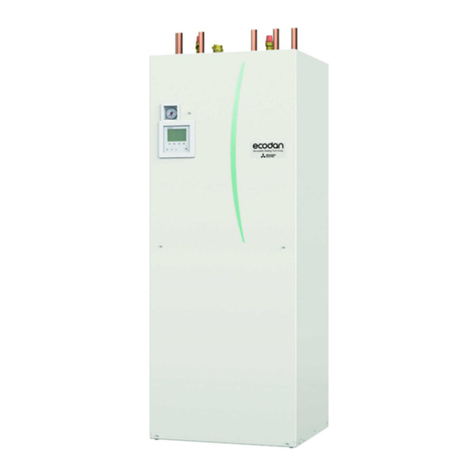
Mitsubishi Electric
Mitsubishi Electric EHPT Series Operation manual
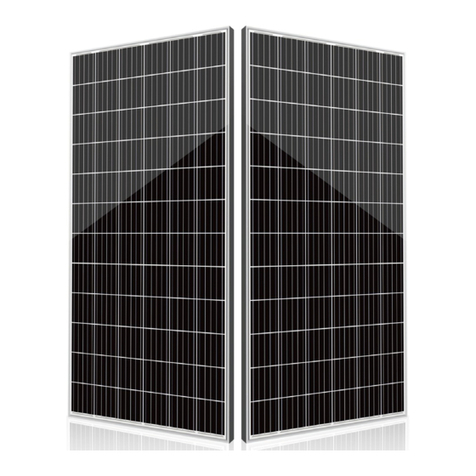
ECO DELTA POWER
ECO DELTA POWER ECO-M-72S Series installation manual
